E-Branchformer: Branchformer with Enhanced merging for speech recognition
Sep 30, 2022Kwangyoun Kim, Felix Wu, Yifan Peng, Jing Pan, Prashant Sridhar, Kyu J. Han, Shinji Watanabe
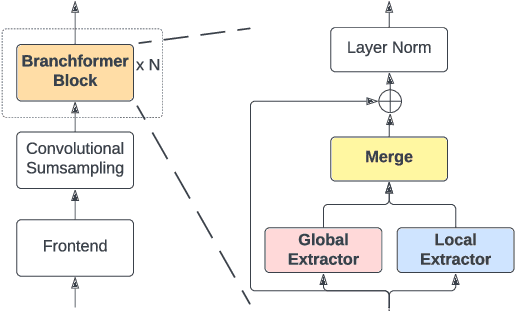
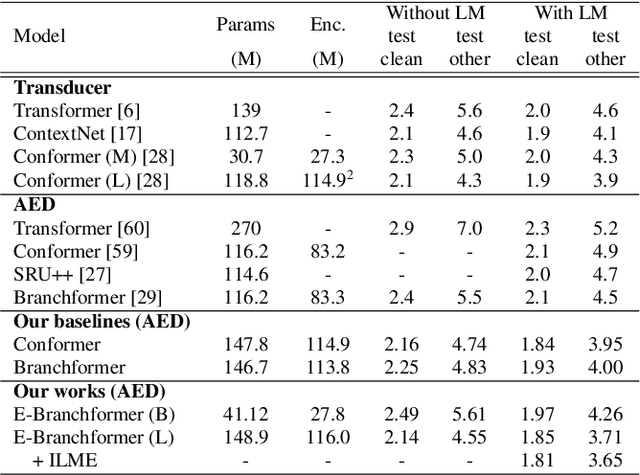
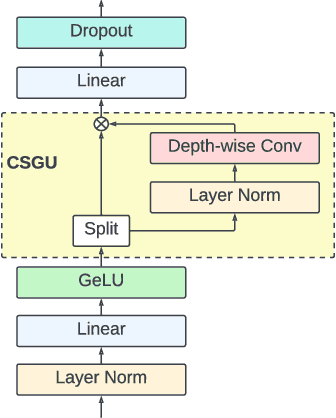

Conformer, combining convolution and self-attention sequentially to capture both local and global information, has shown remarkable performance and is currently regarded as the state-of-the-art for automatic speech recognition (ASR). Several other studies have explored integrating convolution and self-attention but they have not managed to match Conformer's performance. The recently introduced Branchformer achieves comparable performance to Conformer by using dedicated branches of convolution and self-attention and merging local and global context from each branch. In this paper, we propose E-Branchformer, which enhances Branchformer by applying an effective merging method and stacking additional point-wise modules. E-Branchformer sets new state-of-the-art word error rates (WERs) 1.81% and 3.65% on LibriSpeech test-clean and test-other sets without using any external training data.
ESPnet-ONNX: Bridging a Gap Between Research and Production
Sep 20, 2022Masao Someki, Yosuke Higuchi, Tomoki Hayashi, Shinji Watanabe
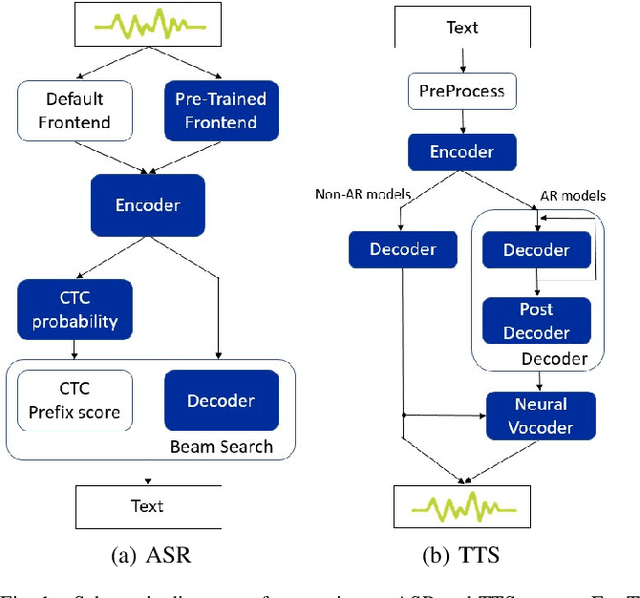
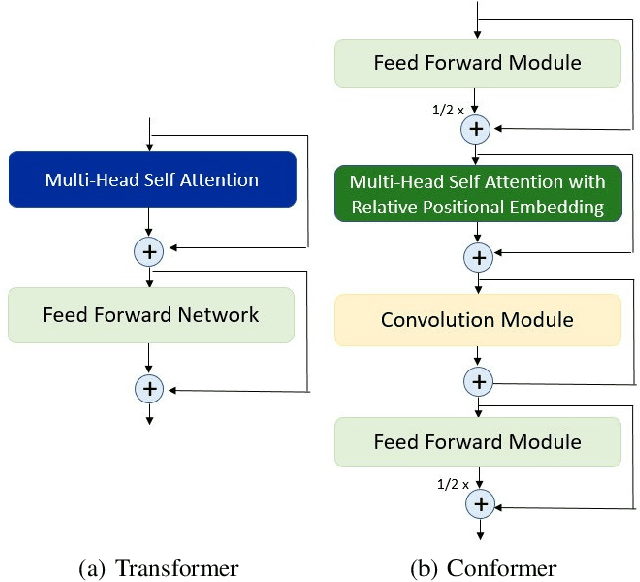
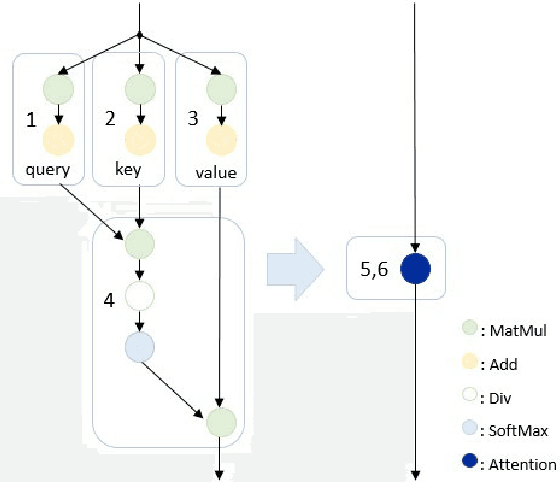

In the field of deep learning, researchers often focus on inventing novel neural network models and improving benchmarks. In contrast, application developers are interested in making models suitable for actual products, which involves optimizing a model for faster inference and adapting a model to various platforms (e.g., C++ and Python). In this work, to fill the gap between the two, we establish an effective procedure for optimizing a PyTorch-based research-oriented model for deployment, taking ESPnet, a widely used toolkit for speech processing, as an instance. We introduce different techniques to ESPnet, including converting a model into an ONNX format, fusing nodes in a graph, and quantizing parameters, which lead to approximately 1.3-2$\times$ speedup in various tasks (i.e., ASR, TTS, speech translation, and spoken language understanding) while keeping its performance without any additional training. Our ESPnet-ONNX will be publicly available at https://github.com/espnet/espnet_onnx
Deep Speech Synthesis from Articulatory Representations
Sep 13, 2022Peter Wu, Shinji Watanabe, Louis Goldstein, Alan W Black, Gopala K. Anumanchipalli
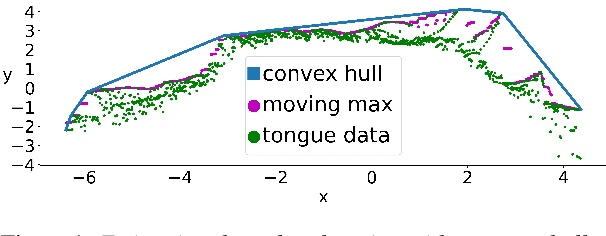

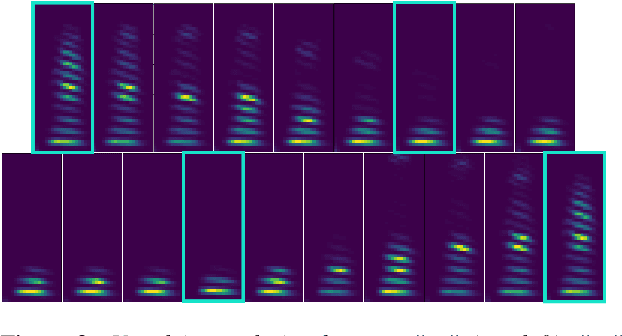
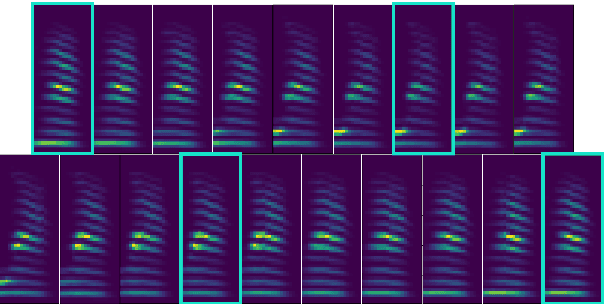
In the articulatory synthesis task, speech is synthesized from input features containing information about the physical behavior of the human vocal tract. This task provides a promising direction for speech synthesis research, as the articulatory space is compact, smooth, and interpretable. Current works have highlighted the potential for deep learning models to perform articulatory synthesis. However, it remains unclear whether these models can achieve the efficiency and fidelity of the human speech production system. To help bridge this gap, we propose a time-domain articulatory synthesis methodology and demonstrate its efficacy with both electromagnetic articulography (EMA) and synthetic articulatory feature inputs. Our model is computationally efficient and achieves a transcription word error rate (WER) of 18.5% for the EMA-to-speech task, yielding an improvement of 11.6% compared to prior work. Through interpolation experiments, we also highlight the generalizability and interpretability of our approach.
TF-GridNet: Making Time-Frequency Domain Models Great Again for Monaural Speaker Separation
Sep 08, 2022Zhong-Qiu Wang, Samuele Cornell, Shukjae Choi, Younglo Lee, Byeong-Yeol Kim, Shinji Watanabe
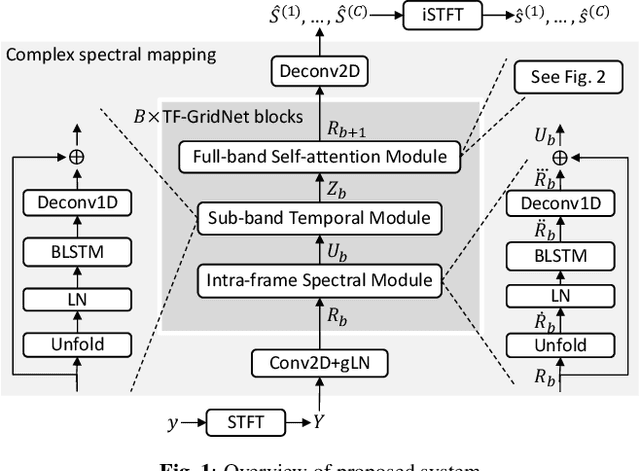
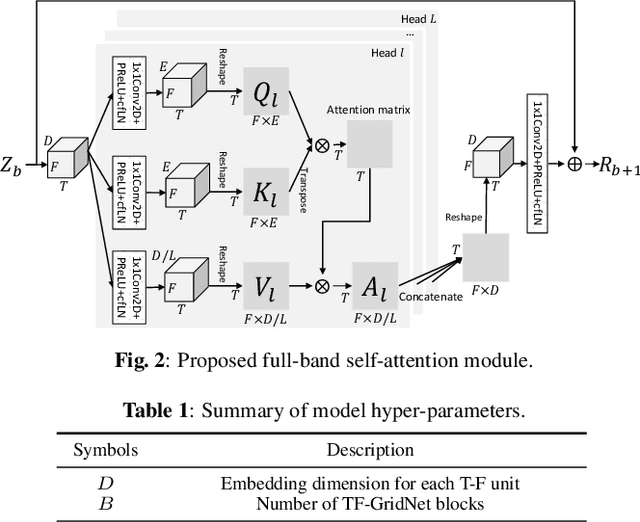
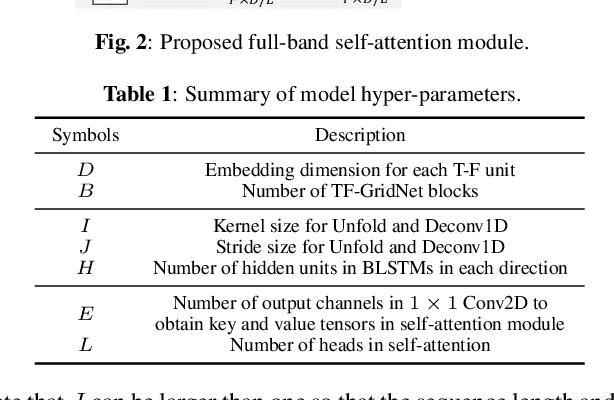

We propose TF-GridNet, a novel multi-path deep neural network (DNN) operating in the time-frequency (T-F) domain, for monaural talker-independent speaker separation in anechoic conditions. The model stacks several multi-path blocks, each consisting of an intra-frame spectral module, a sub-band temporal module, and a full-band self-attention module, to leverage local and global spectro-temporal information for separation. The model is trained to perform complex spectral mapping, where the real and imaginary (RI) components of the input mixture are stacked as input features to predict the target RI components. Besides using the scale-invariant signal-to-distortion ratio (SI-SDR) loss for model training, we include a novel loss term to encourage the separated sources to add up to the input mixture. Without using dynamic mixing, we obtain 23.4 dB SI-SDR improvement (SI-SDRi) on the WSJ0-2mix dataset, outperforming the previous best by a large margin.
ASR2K: Speech Recognition for Around 2000 Languages without Audio
Sep 06, 2022Xinjian Li, Florian Metze, David R Mortensen, Alan W Black, Shinji Watanabe

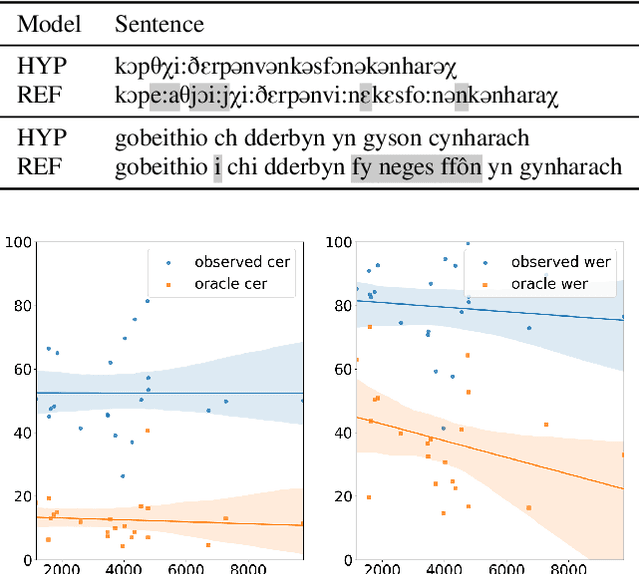


Most recent speech recognition models rely on large supervised datasets, which are unavailable for many low-resource languages. In this work, we present a speech recognition pipeline that does not require any audio for the target language. The only assumption is that we have access to raw text datasets or a set of n-gram statistics. Our speech pipeline consists of three components: acoustic, pronunciation, and language models. Unlike the standard pipeline, our acoustic and pronunciation models use multilingual models without any supervision. The language model is built using n-gram statistics or the raw text dataset. We build speech recognition for 1909 languages by combining it with Crubadan: a large endangered languages n-gram database. Furthermore, we test our approach on 129 languages across two datasets: Common Voice and CMU Wilderness dataset. We achieve 50% CER and 74% WER on the Wilderness dataset with Crubadan statistics only and improve them to 45% CER and 69% WER when using 10000 raw text utterances.
VQ-T: RNN Transducers using Vector-Quantized Prediction Network States
Aug 03, 2022Jiatong Shi, George Saon, David Haws, Shinji Watanabe, Brian Kingsbury
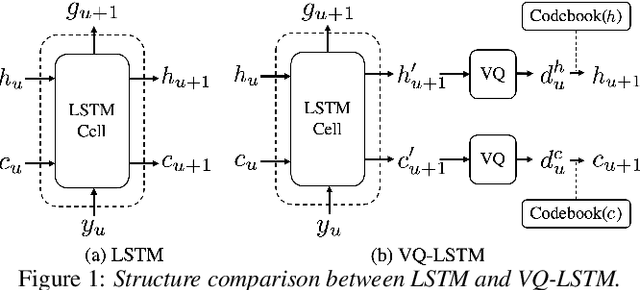
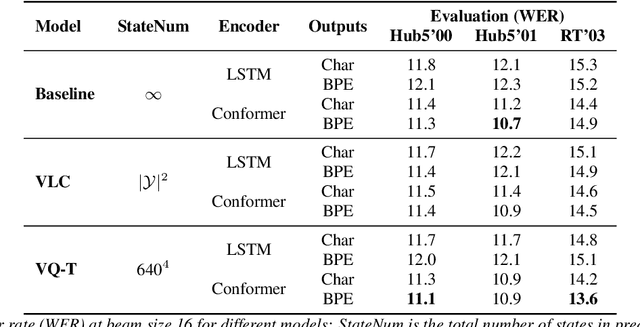

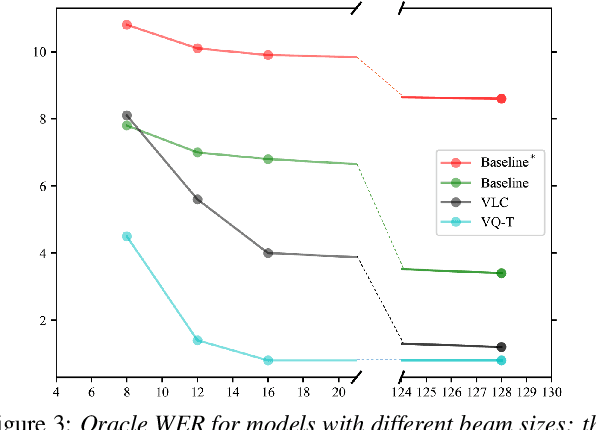
Beam search, which is the dominant ASR decoding algorithm for end-to-end models, generates tree-structured hypotheses. However, recent studies have shown that decoding with hypothesis merging can achieve a more efficient search with comparable or better performance. But, the full context in recurrent networks is not compatible with hypothesis merging. We propose to use vector-quantized long short-term memory units (VQ-LSTM) in the prediction network of RNN transducers. By training the discrete representation jointly with the ASR network, hypotheses can be actively merged for lattice generation. Our experiments on the Switchboard corpus show that the proposed VQ RNN transducers improve ASR performance over transducers with regular prediction networks while also producing denser lattices with a very low oracle word error rate (WER) for the same beam size. Additional language model rescoring experiments also demonstrate the effectiveness of the proposed lattice generation scheme.
When Is TTS Augmentation Through a Pivot Language Useful?
Jul 20, 2022Nathaniel Robinson, Perez Ogayo, Swetha Gangu, David R. Mortensen, Shinji Watanabe
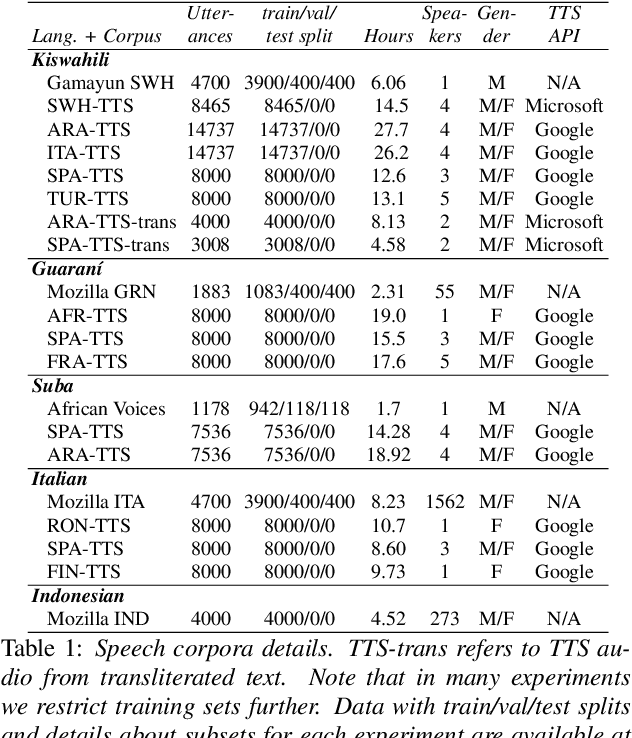
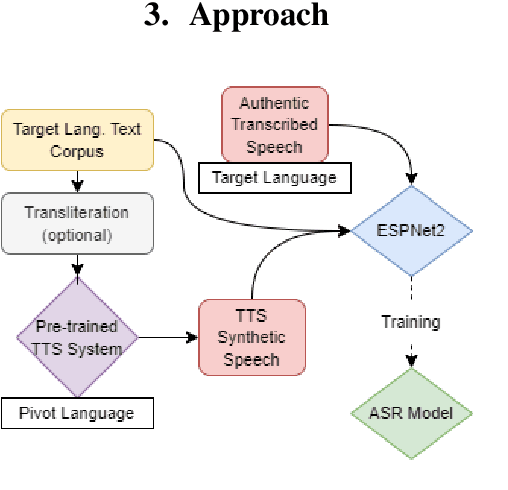
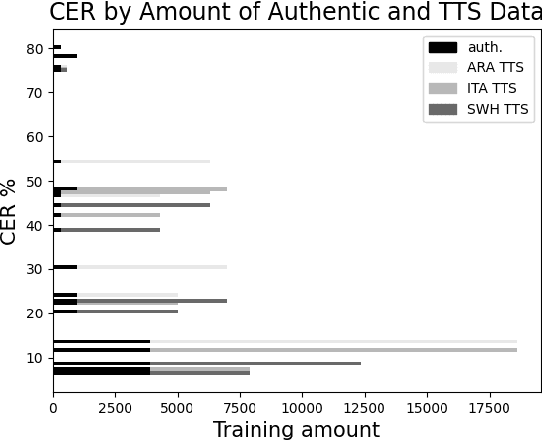
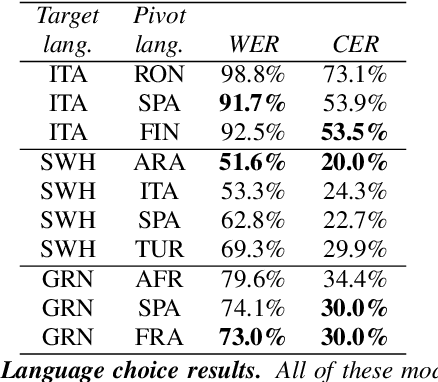
Developing Automatic Speech Recognition (ASR) for low-resource languages is a challenge due to the small amount of transcribed audio data. For many such languages, audio and text are available separately, but not audio with transcriptions. Using text, speech can be synthetically produced via text-to-speech (TTS) systems. However, many low-resource languages do not have quality TTS systems either. We propose an alternative: produce synthetic audio by running text from the target language through a trained TTS system for a higher-resource pivot language. We investigate when and how this technique is most effective in low-resource settings. In our experiments, using several thousand synthetic TTS text-speech pairs and duplicating authentic data to balance yields optimal results. Our findings suggest that searching over a set of candidate pivot languages can lead to marginal improvements and that, surprisingly, ASR performance can by harmed by increases in measured TTS quality. Application of these findings improves ASR by 64.5\% and 45.0\% character error reduction rate (CERR) respectively for two low-resource languages: Guaran\'i and Suba.
ESPnet-SE++: Speech Enhancement for Robust Speech Recognition, Translation, and Understanding
Jul 19, 2022Yen-Ju Lu, Xuankai Chang, Chenda Li, Wangyou Zhang, Samuele Cornell, Zhaoheng Ni, Yoshiki Masuyama, Brian Yan, Robin Scheibler, Zhong-Qiu Wang, Yu Tsao, Yanmin Qian, Shinji Watanabe
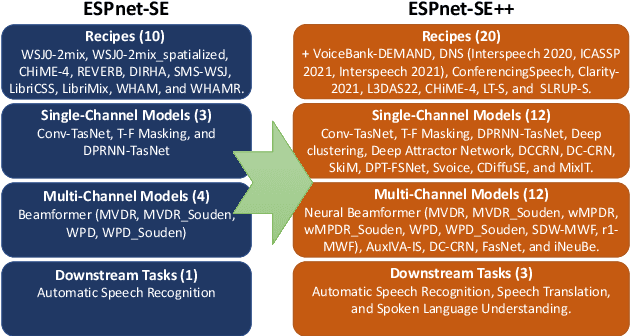
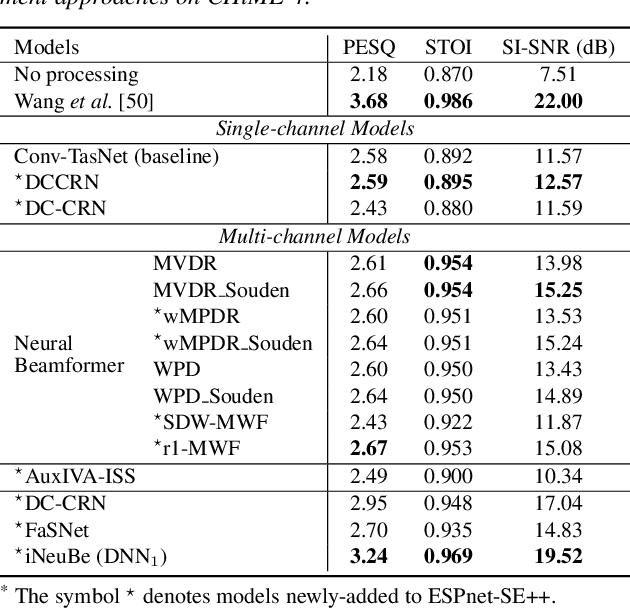
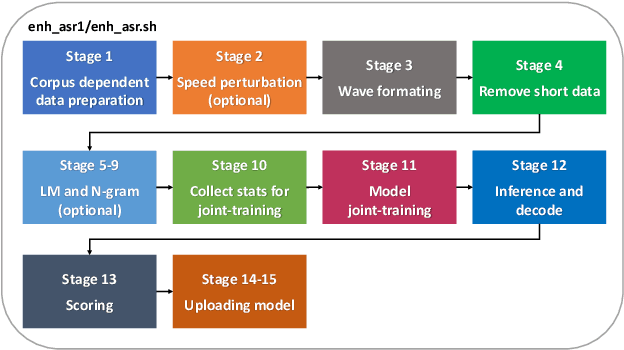
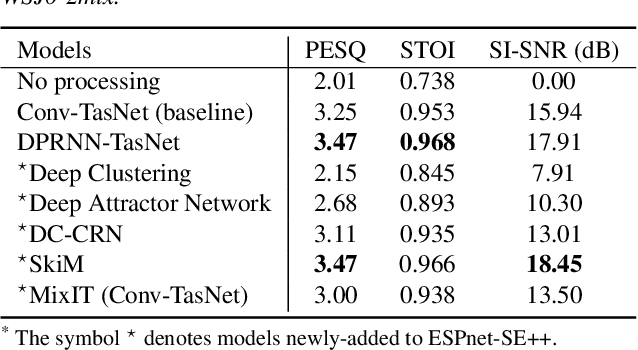
This paper presents recent progress on integrating speech separation and enhancement (SSE) into the ESPnet toolkit. Compared with the previous ESPnet-SE work, numerous features have been added, including recent state-of-the-art speech enhancement models with their respective training and evaluation recipes. Importantly, a new interface has been designed to flexibly combine speech enhancement front-ends with other tasks, including automatic speech recognition (ASR), speech translation (ST), and spoken language understanding (SLU). To showcase such integration, we performed experiments on carefully designed synthetic datasets for noisy-reverberant multi-channel ST and SLU tasks, which can be used as benchmark corpora for future research. In addition to these new tasks, we also use CHiME-4 and WSJ0-2Mix to benchmark multi- and single-channel SE approaches. Results show that the integration of SE front-ends with back-end tasks is a promising research direction even for tasks besides ASR, especially in the multi-channel scenario. The code is available online at https://github.com/ESPnet/ESPnet. The multi-channel ST and SLU datasets, which are another contribution of this work, are released on HuggingFace.
Two-Pass Low Latency End-to-End Spoken Language Understanding
Jul 14, 2022Siddhant Arora, Siddharth Dalmia, Xuankai Chang, Brian Yan, Alan Black, Shinji Watanabe

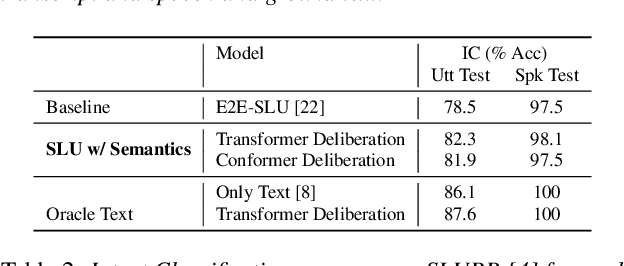
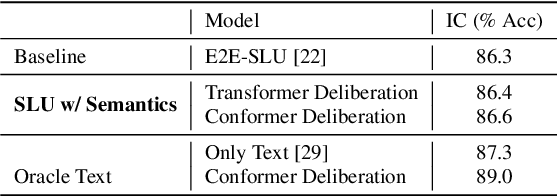
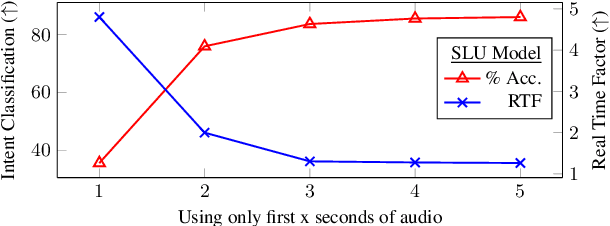
End-to-end (E2E) models are becoming increasingly popular for spoken language understanding (SLU) systems and are beginning to achieve competitive performance to pipeline-based approaches. However, recent work has shown that these models struggle to generalize to new phrasings for the same intent indicating that models cannot understand the semantic content of the given utterance. In this work, we incorporated language models pre-trained on unlabeled text data inside E2E-SLU frameworks to build strong semantic representations. Incorporating both semantic and acoustic information can increase the inference time, leading to high latency when deployed for applications like voice assistants. We developed a 2-pass SLU system that makes low latency prediction using acoustic information from the few seconds of the audio in the first pass and makes higher quality prediction in the second pass by combining semantic and acoustic representations. We take inspiration from prior work on 2-pass end-to-end speech recognition systems that attends on both audio and first-pass hypothesis using a deliberation network. The proposed 2-pass SLU system outperforms the acoustic-based SLU model on the Fluent Speech Commands Challenge Set and SLURP dataset and reduces latency, thus improving user experience. Our code and models are publicly available as part of the ESPnet-SLU toolkit.
Improving Speech Enhancement through Fine-Grained Speech Characteristics
Jul 11, 2022Muqiao Yang, Joseph Konan, David Bick, Anurag Kumar, Shinji Watanabe, Bhiksha Raj
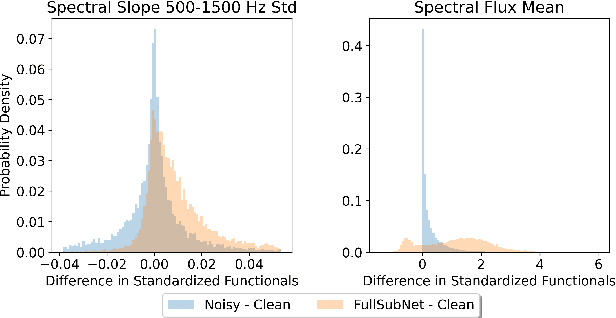
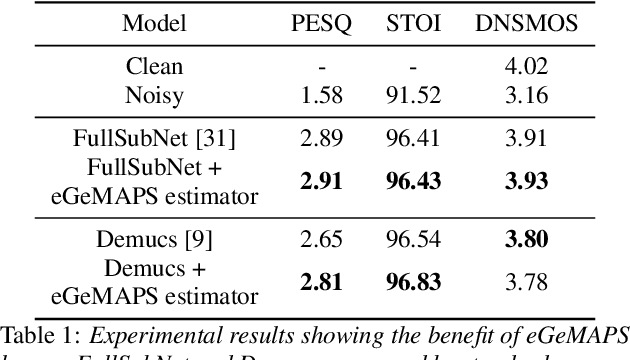

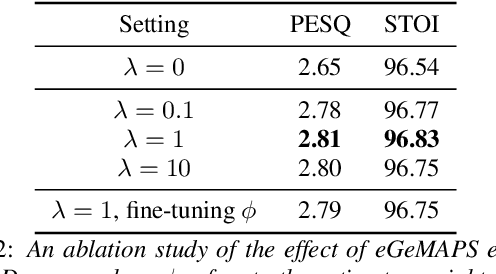
While deep learning based speech enhancement systems have made rapid progress in improving the quality of speech signals, they can still produce outputs that contain artifacts and can sound unnatural. We propose a novel approach to speech enhancement aimed at improving perceptual quality and naturalness of enhanced signals by optimizing for key characteristics of speech. We first identify key acoustic parameters that have been found to correlate well with voice quality (e.g. jitter, shimmer, and spectral flux) and then propose objective functions which are aimed at reducing the difference between clean speech and enhanced speech with respect to these features. The full set of acoustic features is the extended Geneva Acoustic Parameter Set (eGeMAPS), which includes 25 different attributes associated with perception of speech. Given the non-differentiable nature of these feature computation, we first build differentiable estimators of the eGeMAPS and then use them to fine-tune existing speech enhancement systems. Our approach is generic and can be applied to any existing deep learning based enhancement systems to further improve the enhanced speech signals. Experimental results conducted on the Deep Noise Suppression (DNS) Challenge dataset shows that our approach can improve the state-of-the-art deep learning based enhancement systems.
 Add to Chrome
Add to Chrome Add to Firefox
Add to Firefox Add to Edge
Add to Edge